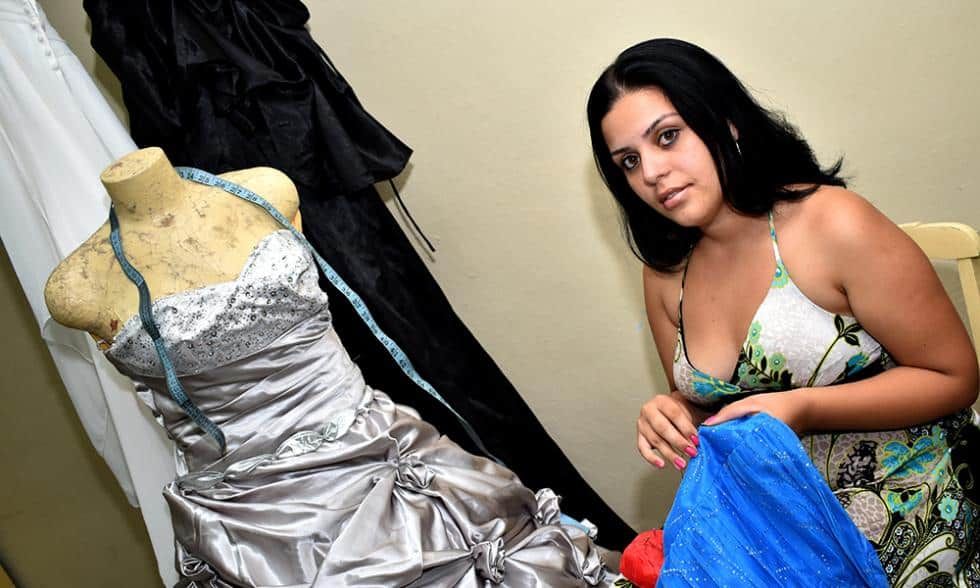Grey reinforces the stitches on the new dress that will adapt to many young girls’ waistlines. She inspects the work while she touches up the details on the embroidered band that once embellished the finest lingerie. She admires the harmony of her perfect piece made out of bits and pieces.
“I have a special passion for period dresses. The ones that the majority of Cubans wear when we turn 15 years old. Bespoke haute couture. Luckily, it’s still an active tradition. I make a living with these beautiful relics. I make them with materials I recycle.”
She grew up among needles and bobbins of thread. “All of the women in my family sew,” the young craftswoman says proudly. She learned the art of stitching from her mother. “I would have liked to have studied it, but I learned on my own.”
At 21 years old, Grey boasts a refined skill for making dresses that are destined to hang off hangers at Placetas’ photo shoots: “My goddaughter was turning five years old and she asked me to make her a princess dress as a present. That was my first job. I was 16 at the time. The most difficult for me, even today, is to visualize the dress. I don’t use paper, I don’t make any sketches. The design is mental. I get inspiration from fashion magazines and the photos I see online. But one thing’s for sure, every single one of my dresses are exclusive. None of them are the same.”
Recycling is the soul of Grey’s creations. She has a special gift for transforming the obsolete. “I recycle because I need to,” she clarifies. “Generally-speaking, stone and sequin accessories are in shortage on our market. It’s hard to find them in hard-currency stores. Sometimes, I buy a couple of meters of satin or another fabric when they put them out.”
Finding, sorting and taking apart old clothes is a necessary exercise for this fashion designer: “I find lots of things at used clothes markets. I have bought a dress for its fasteners only. I adapt the creations to the resources they turn up. I work with clothes that people no longer wear. I buy some of them, others are given to me. You can’t imagine the extremely old clothes I’ve taken apart. Jackets, dresses, skirts, … shirts, all of them older than my grandmother. I enjoy seeing and learning when I look at the complexity of the work of fashion in the past. Everything is much less elaborated nowadays.”
Every night, Grey transforms her living room at home into her sewing workshop. She moves the furniture to one side and covers the floor with the clothing she needs. “I begin sewing at about 8 PM, as I teach at a primary school in the mornings and afternoons. It takes me up to 20 days to finish a complete piece. It’s a very detailed and artistic job.”
According to Mercedes Lorenzo, a self-employed photographer, Grey’s dresses are in no way inferior to the original pieces. “Satisfying the requests of girls turning 15 is becoming a more and more expensive challenge for photo studios. None of them want to wear a dress someone else has worn. Buying new accessories and dresses all the time is an investment we can’t afford. There isn’t anywhere where you can get these dresses and you have to pay excessive prices on the “scheming” market. They are brought over from Panama, Guyana, Mexico. But, they are really expensive. Grey gives you the opportunity to alter pieces that are already “burnt out”, like the girls say, for an affordable price. Plus, they are signature pieces. They are never the same.”“I rent out my dresses to photographic studios. I get the most out of them that way. I also sell them by order. The most I can ask for a piece is 100 CUC. If you compare the amount of time invested into making each dress, you’ll see that the money I earn in selling a dress isn’t enough to get rich. That’s why I prefer to hire them out. My dresses work out much cheaper for photographers. If you order them abroad, they can charge up to 300 CUC for dresses which are very cheap abroad. In Cuba, there are very few stores where studios can go to get these kinds of dresses. That’s my advantage.”
Demand grows every day. However, the young woman can’t take on all her orders: “I dream of having my own atelier with all the conditions necessary. Sewing on a big scale. But, that doesn’t depend on me. First, I need a market where I can buy the materials I need: fabrics, adornments, gemstones, sequins, fasteners, in a steady way for a reasonable price. In the meantime, I make a living by recycling.”
This article was translated by Havana Times from the original published in Spanish.










Comments
We moderate comments on this site. If you want to know more details, read our Privacy Policy
Your email address will not be published. Mandatory fields are marked with *